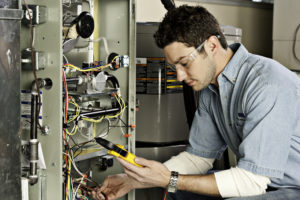Green Technology and What You Should Know
 Are you eco-conscious and interested in the technologies of HVAC systems? If this sounds like you, then becoming an HVAC technician that support green technology may be your calling. As an HVAC technician, you can help clients stay comfortable in their homes while helping climate changes at the same time. It’s a win-win. So, what are renewable energy and green power?
Are you eco-conscious and interested in the technologies of HVAC systems? If this sounds like you, then becoming an HVAC technician that support green technology may be your calling. As an HVAC technician, you can help clients stay comfortable in their homes while helping climate changes at the same time. It’s a win-win. So, what are renewable energy and green power?
What are Renewable Energy and Green Power?
Renewable energy and green power sources are an important part of the fight against climate change. These energy and green power sources include:
Renewable Energy
Renewable energy sources can come from many different places, including large hydropower and municipal solid waste systems. These take waste products and unused water resources and recycles them to create renewable energy.
Green Power Sources
Green power is created by wind, solar, biomass, geothermal, biogas, and low-impact hydropower.
Wind – the process of using wind to generate mechanical power and electricity. Wind turbines convert the kinetic energy from wind into mechanical power. The mechanical power is converted into electricity by a generator.
Solar – converts sunlight into electrical energy through photovoltaic panels or using mirrors that concentrate solar radiation on a water source.
Biomass – an organic source of energy, made of materials that come from living organisms. Biomass materials are commonly made up of plants, wood, and waste.
Geothermal – heat from within the earth. A renewable energy extracted from the natural heat produced inside the earth.
Biogas – energy is produced when organic matter is broken down by microorganisms in the absence of oxygen. Biogas can be created using manure, waste, plant materials, food waste and sewage.
What is Green Technology?
Green and eco-technology includes sustainable and environmentally friendly technology. The goal of green technology is to bring innovation and change to build clean and sustainable communities. Some examples of green technology include green energy, green buildings, and green chemistry.
Green Technology in HVAC
While traditional heating and air conditioning systems can produce ozone-depleting gases, we are always looking for alternatives to lower our carbon footprint. Much of the greenhouse gas emissions come from the burning of fossil fuels in homes and buildings for heating and air conditioning. Here are a few HVAC components that can help the environment:
Smart Thermostats – can learn your habits and adjust the temperature based on your schedule.
Air Source Heath Pumps – uses ambient air outside a building as a heat source.
Geothermal Heat Pumps – heat source from the solar energy stored in the ground. The heat pump takes advantage of the constant temperature of geothermal wells under the ground. A geothermal heat pump can cool a house in the summer and warm it during the winter.
Ice Powered Air Conditioning – freezes a large quantity of water at night and then uses the ice during the day to refrigerate and cool the air.
Solar Power – uses energy from the sun and converts it into green energy. Solar is constant and renewable. Solar cells on residential roofs contain photovoltaic materials, and the unused energy can flow back into the electrical grid.
What is a Smart House?
A smart home uses internet-connected devices to enable remote monitoring of HVAC systems, lighting, Wi-Fi, alarm systems and other elements of the home. Smart houses allow residences greater control of their energy usage, and can automate temperature, turning off lights and adjusting HVAC systems based on weather conditions. Smart homes can even track usage and make automated changes to improve energy usage on the resident’s behalf.
What is a Smart Device?
An electronic device connected to the smart home system that can interact with a Wi-Fi network of devices to make decisions to improve energy efficiency. Some examples of smart devices are televisions, light bulbs, HVAC systems, thermostats, refrigerators, and doorbells.
Why Use Green Technology?
There are many benefits to using green technology for HVAC systems. These benefits include:
Lower Energy Costs
Using green technology can reduce the cost of electricity usage and can be extremely significant for larger buildings. Green technology can reduce the use of electricity, natural gas, and water resources.
Utilize Energy Reduction Incentives
Residents can take advantage of Energy Star technology and rebates from their gas and electric providers. These incentives reduce the cost of energy and save the resident money at the same time.
Better Air Quality
Heat pumps don’t burn fossil fuels and produce lower carbon monoxide exposure.
Regulatory Compliance
Many municipalities are enacting regulations that focus on green technology. It is important to understand what your city guidelines are, so you don’t get fined. One regulation that is sweeping the US is the restriction of fireplace usage. Although it is a very inexpensive way to heat the home, burning the wood can expose our planet to extreme climate conditions.
Final Thoughts
Now that you know what green technology is and how it can help the environment, it is time to learn more about Ohio Business College. We offer an HVAC/R program that teaches you about important topics like green technology. Become an HVAC technician that is a positive force to combat climate change. It’s a rewarding feeling.
Want to Learn More?
If you have a passion for heating and cooling, working in the HVAC/R industry might just be for you. However, entering a career in a field as potentially rewarding as HVAC/R all starts with a trade school training program. At Ohio Business College, we can help you gain the skills and knowledge that can serve as the foundation of a rewarding career as an HVAC/R technician.
If you are interested in a HVAC/R profession, let Ohio Business College answer any questions you may have. Contact us today to learn more about our Truck Driving programs.

